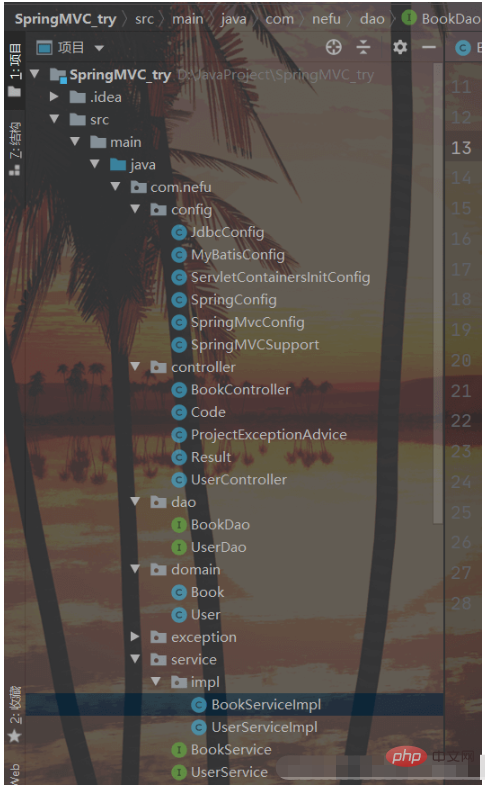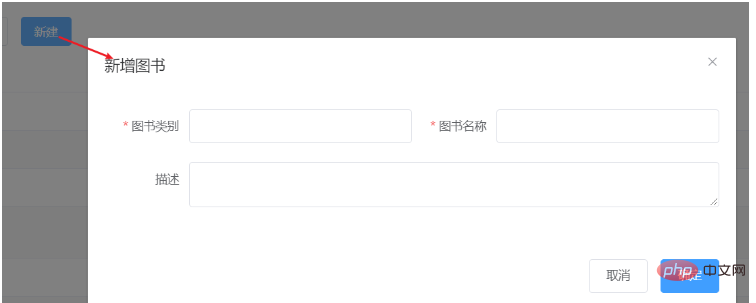 Java
Java
 javaTutorial
javaTutorial
 How to use Java SSM to implement joint debugging of front-end and back-end protocols
How to use Java SSM to implement joint debugging of front-end and back-end protocols
How to use Java SSM to implement joint debugging of front-end and back-end protocols
Environment preparation
The project structure is the same as before:

We add new static resources:

Because static resources are added, SpringMVC will intercept them. All static resources need to be released in the SpringConfig configuration class:
We create a new SpringMvcSupport
@Configuration
public class SpringMvcSupport extends WebMvcConfigurationSupport {
@Override
protected void addResourceHandlers(ResourceHandlerRegistry registry) {
registry.addResourceHandler("/pages/**").addResourceLocations("/pages/");
registry.addResourceHandler("/css/**").addResourceLocations("/css/");
registry.addResourceHandler("/js/**").addResourceLocations("/js/");
registry.addResourceHandler("/plugins/**").addResourceLocations("/plugins/");
}
}After the configuration is completed, we need to Scan SpringMvcSupport in SpringMvcConfig:
@Configuration
@ComponentScan({"com.nefu.controller","com.nefu.config"})
@EnableWebMvc
public class SpringMvcConfig {
}Next we need to implement all list query, addition, modification, deletion and other functions one by one.
List function

Requirements: After the page is loaded, send an asynchronous request to the background to obtain the list data for display.
Find the hook function of the page,
created()created()method Called thethis.getAll()methodUse axios in the getAll() method to send an asynchronous request to obtain data from the background
-
The access path is
http://localhost/books Return data
Return data res. The content of data is as follows:
{
Sending method:
"data": [
" "id": 1,
"type": "Computer Theory",
"name": "Spring Practical Fifth Edition",
"Description": "Classic tutorial for getting started with Spring, in-depth understanding of Spring principles and technology"
},
"id": 2 ,
"type": "Computer Theory",
"name": "Spring 5 Core Principles and 30 Kinds of Handwriting Practice",
"description": "Ten Years of Precipitation, The Essence of Handwriting Spring Thoughts"
},...
],
"code": 20041,
"msg": ""
}
getAll() {
//发送ajax请求
axios.get("/books").then((res)=>{
this.dataList = res.data.data;
});
} Add function
Add function
 Requirement: Complete the new function module of the picture
Requirement: Complete the new function module of the picture
- Find the new button on the page, which is bound to
- @click="handleCreate()"
Method
Find - handleCreate in method
Method, open the new panel in the method
Find the OK button in the new panel, the button is bound - @click="handleAdd()"
Method
Find in method - handleAdd
Method
Send the request and data in the method. After the response is successful, the new Close the new panel and query the data again - ##handleCreate
handleCreate() {
this.dialogFormVisible = true;
},handleAdd () {
//发送ajax请求
//this.formData是表单中的数据,最后是一个json数据
axios.post("/books",this.formData).then((res)=>{
this.dialogFormVisible = false;
this.getAll();
});
}Add function status processingThe basic new functions have been completed, but there are still some problems that need to be solved:Requirements: The panel is closed if the new addition is successful. Query the data again, what should you do if the new addition fails? 1. In the handlerAdd method, perform different processing according to the data returned by the background 2. If the background returns success, It will prompt a success message and close the panel3. If the background returns failure, it will prompt an error message(1) Modify the front-end pagehandleAdd () {
//发送ajax请求
axios.post("/books",this.formData).then((res)=>{
//如果操作成功,关闭弹层,显示数据
if(res.data.code == 20011){
this.dialogFormVisible = false;
this.$message.success("添加成功");
}else if(res.data.code == 20010){
this.$message.error("添加失败");
}else{
this.$message.error(res.data.msg);
}
}).finally(()=>{
this.getAll();
});
}void
toint
public interface BookDao {
// @Insert("insert into tbl_book values(null,#{type},#{name},#{description})")
@Insert("insert into tbl_book (type,name,description) values(#{type},#{name},#{description})")
public int save(Book book);
@Update("update tbl_book set type = #{type}, name = #{name}, description = #{description} where id = #{id}")
public int update(Book book);
@Delete("delete from tbl_book where id = #{id}")
public int delete(Integer id);
@Select("select * from tbl_book where id = #{id}")
public Book getById(Integer id);
@Select("select * from tbl_book")
public List<Book> getAll();
}(3) In BookServiceImpl, the addition, deletion and modification methods are based on DAO's The return value determines whether to return true/false@Service
public class BookServiceImpl implements BookService {
@Autowired
private BookDao bookDao;
public boolean save(Book book) {
return bookDao.save(book) > 0;
}
public boolean update(Book book) {
return bookDao.update(book) > 0;
}
public boolean delete(Integer id) {
return bookDao.delete(id) > 0;
}
public Book getById(Integer id) {
if(id == 1){
throw new BusinessException(Code.BUSINESS_ERR,"请不要使用你的技术挑战我的耐性!");
}
// //将可能出现的异常进行包装,转换成自定义异常
// try{
// int i = 1/0;
// }catch (Exception e){
// throw new SystemException(Code.SYSTEM_TIMEOUT_ERR,"服务器访问超时,请重试!",e);
// }
return bookDao.getById(id);
}
public List<Book> getAll() {
return bookDao.getAll();
}
}After processing the new addition Afterwards, you will find that there is still a problem with the new addition. 
resetForm(){
this.formData = {};
}
handleCreate() {
this.dialogFormVisible = true;
this.resetForm();
}The above is the detailed content of How to use Java SSM to implement joint debugging of front-end and back-end protocols. For more information, please follow other related articles on the PHP Chinese website!

Hot AI Tools

Undresser.AI Undress
AI-powered app for creating realistic nude photos

AI Clothes Remover
Online AI tool for removing clothes from photos.

Undress AI Tool
Undress images for free

Clothoff.io
AI clothes remover

Video Face Swap
Swap faces in any video effortlessly with our completely free AI face swap tool!

Hot Article

Hot Tools

Notepad++7.3.1
Easy-to-use and free code editor

SublimeText3 Chinese version
Chinese version, very easy to use

Zend Studio 13.0.1
Powerful PHP integrated development environment

Dreamweaver CS6
Visual web development tools

SublimeText3 Mac version
God-level code editing software (SublimeText3)

Hot Topics
 1386
1386
 52
52
 Perfect Number in Java
Aug 30, 2024 pm 04:28 PM
Perfect Number in Java
Aug 30, 2024 pm 04:28 PM
Guide to Perfect Number in Java. Here we discuss the Definition, How to check Perfect number in Java?, examples with code implementation.
 Weka in Java
Aug 30, 2024 pm 04:28 PM
Weka in Java
Aug 30, 2024 pm 04:28 PM
Guide to Weka in Java. Here we discuss the Introduction, how to use weka java, the type of platform, and advantages with examples.
 Smith Number in Java
Aug 30, 2024 pm 04:28 PM
Smith Number in Java
Aug 30, 2024 pm 04:28 PM
Guide to Smith Number in Java. Here we discuss the Definition, How to check smith number in Java? example with code implementation.
 Java Spring Interview Questions
Aug 30, 2024 pm 04:29 PM
Java Spring Interview Questions
Aug 30, 2024 pm 04:29 PM
In this article, we have kept the most asked Java Spring Interview Questions with their detailed answers. So that you can crack the interview.
 Break or return from Java 8 stream forEach?
Feb 07, 2025 pm 12:09 PM
Break or return from Java 8 stream forEach?
Feb 07, 2025 pm 12:09 PM
Java 8 introduces the Stream API, providing a powerful and expressive way to process data collections. However, a common question when using Stream is: How to break or return from a forEach operation? Traditional loops allow for early interruption or return, but Stream's forEach method does not directly support this method. This article will explain the reasons and explore alternative methods for implementing premature termination in Stream processing systems. Further reading: Java Stream API improvements Understand Stream forEach The forEach method is a terminal operation that performs one operation on each element in the Stream. Its design intention is
 TimeStamp to Date in Java
Aug 30, 2024 pm 04:28 PM
TimeStamp to Date in Java
Aug 30, 2024 pm 04:28 PM
Guide to TimeStamp to Date in Java. Here we also discuss the introduction and how to convert timestamp to date in java along with examples.
 Java Program to Find the Volume of Capsule
Feb 07, 2025 am 11:37 AM
Java Program to Find the Volume of Capsule
Feb 07, 2025 am 11:37 AM
Capsules are three-dimensional geometric figures, composed of a cylinder and a hemisphere at both ends. The volume of the capsule can be calculated by adding the volume of the cylinder and the volume of the hemisphere at both ends. This tutorial will discuss how to calculate the volume of a given capsule in Java using different methods. Capsule volume formula The formula for capsule volume is as follows: Capsule volume = Cylindrical volume Volume Two hemisphere volume in, r: The radius of the hemisphere. h: The height of the cylinder (excluding the hemisphere). Example 1 enter Radius = 5 units Height = 10 units Output Volume = 1570.8 cubic units explain Calculate volume using formula: Volume = π × r2 × h (4
 How to Run Your First Spring Boot Application in Spring Tool Suite?
Feb 07, 2025 pm 12:11 PM
How to Run Your First Spring Boot Application in Spring Tool Suite?
Feb 07, 2025 pm 12:11 PM
Spring Boot simplifies the creation of robust, scalable, and production-ready Java applications, revolutionizing Java development. Its "convention over configuration" approach, inherent to the Spring ecosystem, minimizes manual setup, allo



